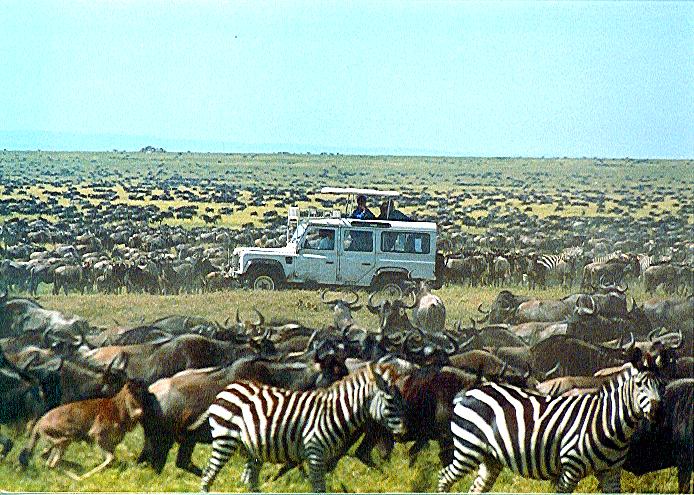
The unequivocal highlight was the day we left Olduvai Gorge for Ndutu, spending the entire day on the grassland plains northeast and south of Naabi Hill. We drove and drove and only rarely found areas with no horizon-to-horizon wildebeest.
Tour organizer Gherry Gustafson said she was “overwhelmed” by the migration. She and her husband, Leland, had just been in Kenya last October and realize now that the migration in the Mara during the dry season is but a fraction of what we see right now on the southern plains of the Serengeti.
On the day we traveled north towards Moru, we could see from Naabi Hill’s viewpoint innumerable files of wilde covering the southern grassland plains, right on queue.
The safari started in fire devastated Arusha National Park, and I could see the effects most seriously in the state of the many previously beautiful crater lakes.
They are all now filled with algae and there was not a bird to be seen. This is the result of heavy ash that “strangled” the lakes. I expect it will take at least a year to fully recycle.
But in Tarangire we hit so many elephant that I keep having to remind myself that this is not “the season” for elephant. And, in fact, true to researcher Charles Foley’s explanations, the ele we saw were all in the northern quadrant, more or less residents or travelers between Tarangire and other northern parks.
Numerous times we were engulfed by ele. Phillip Haney was almost touched by the trunk of a curious bull.
The wetness of the season was evident everywhere, and Lake Manyara – nearly dried out at this time last year – was well beyond its normal shorelines. And as a bonus for us the near shore was plastered with I suspect hundreds of thousands – if not millions – of flamingo.
And the crater was incredibly wet. The Mugie River was overflowing its banks menacingly flooding the northeast sector. And thousands of wilde and zebra were clogging all the roads, since that was the only dry place around.
But the rain was not as heavy as in neighboring Kenya, where floods in the north have been so severe that a number of safari camps and lodges in Samburu have been wiped out.
More on that after my next safari, starting in a few days!